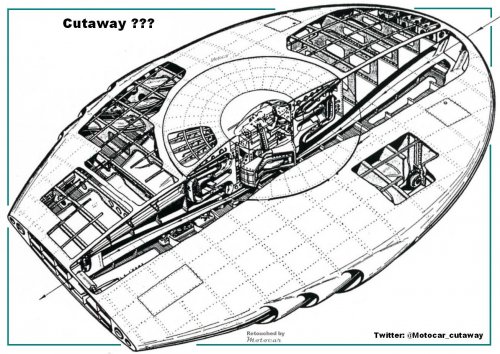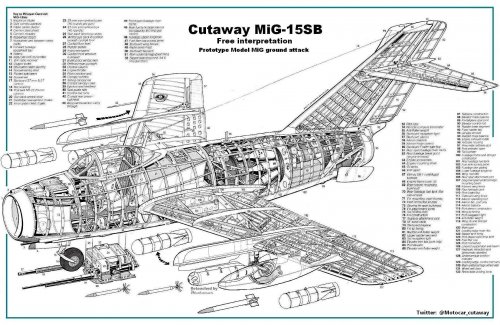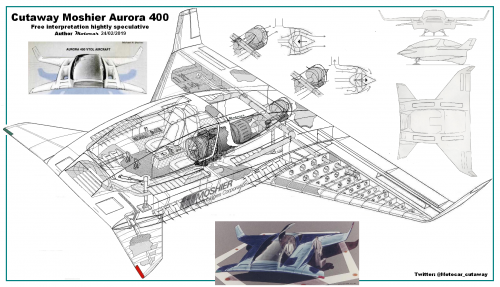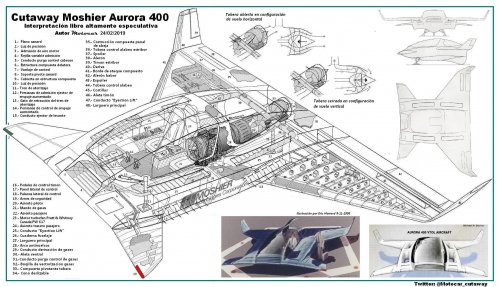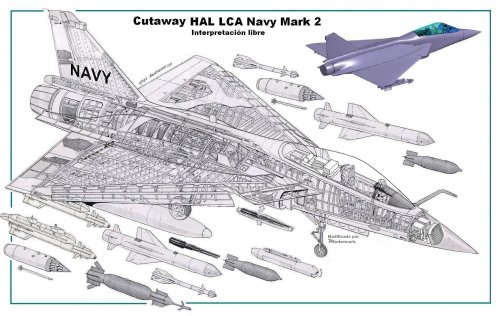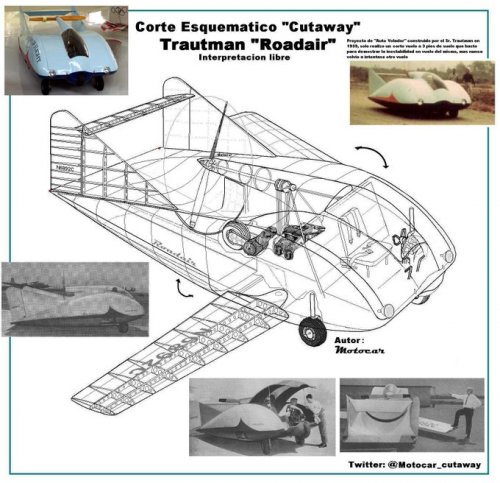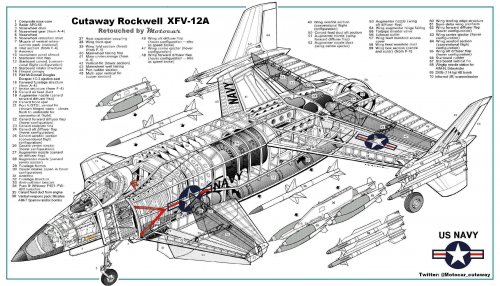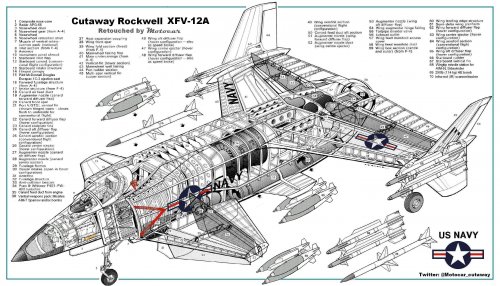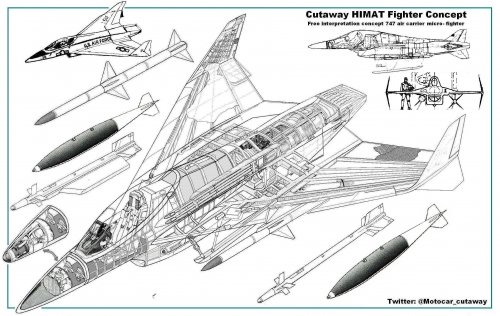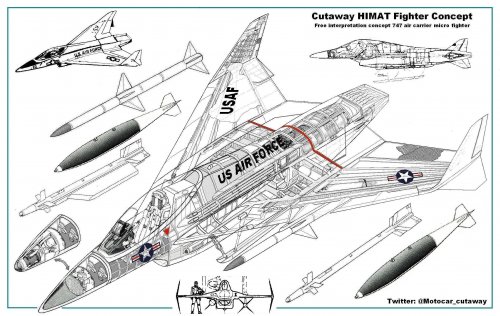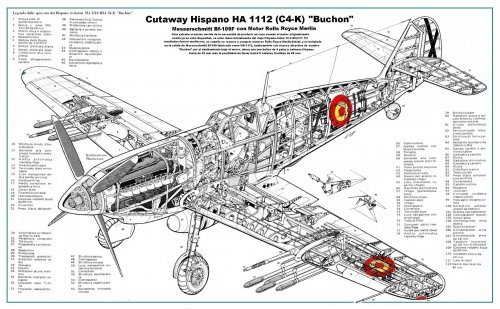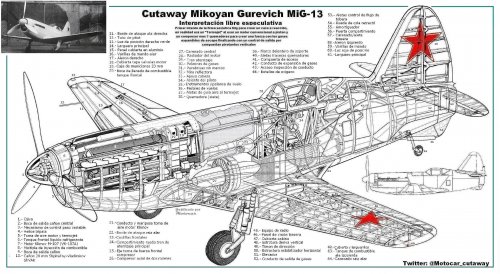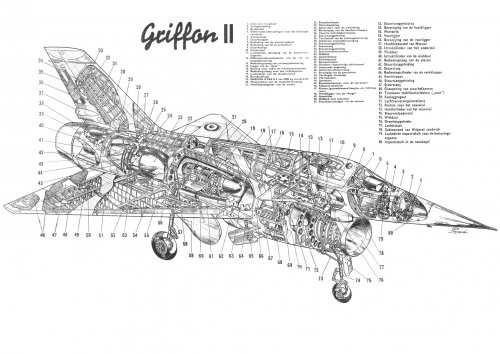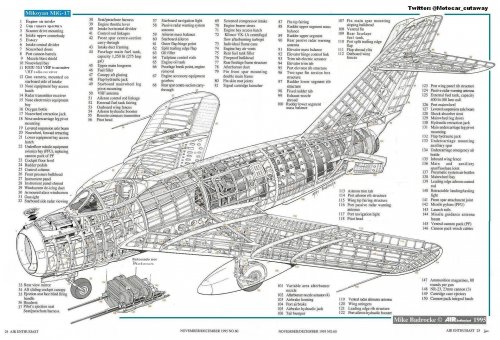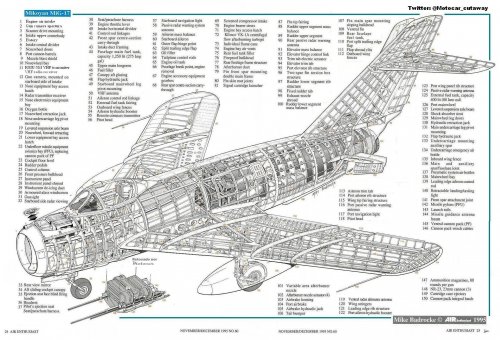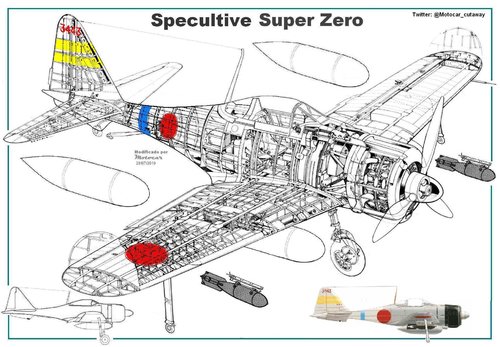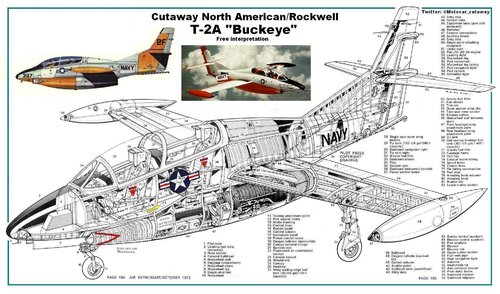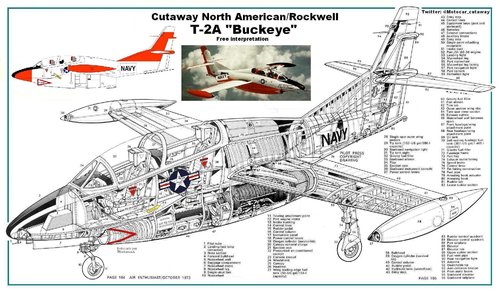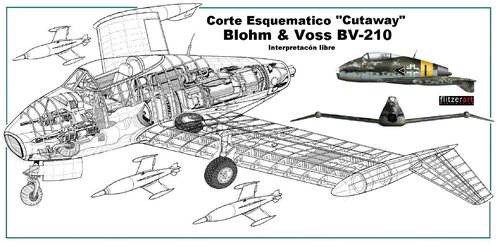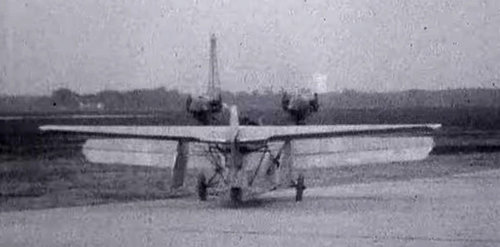You are using an out of date browser. It may not display this or other websites correctly.
You should upgrade or use an alternative browser.
You should upgrade or use an alternative browser.
Motocar's Cutaway drawings
- Thread starter Motocar
- Start date
martinbayer
ACCESS: Top Secret
- Joined
- 6 January 2009
- Messages
- 3,369
- Reaction score
- 3,845
It seems to be one of the Avro Canada designs associated with their Project Y, see for example http://www.laesieworks.com/ifo/lib/AVRO-Omega.html and a similar configuration at https://goo.gl/images/mQXXqJ
Motocar
I really should change my personal text
- Joined
- 16 May 2014
- Messages
- 1,072
- Reaction score
- 1,122
- Joined
- 19 July 2016
- Messages
- 4,265
- Reaction score
- 3,447
Very good, same high standard throughout.
Motocar
I really should change my personal text
- Joined
- 16 May 2014
- Messages
- 1,072
- Reaction score
- 1,122
Cutaway Moshier Aurora 400, Highly speculative schematic cut of the failed project of Michael W. Moshier to create a very advanced VTOL for its time that made use of the "Ejector Lift" technology previously used in the prototype Lockheed XV-4A, which had great difficulties in its development, based In that technology his creator thought about devising, a simpler vehicle that did not go beyond reports in aviation specialized magazines and the publicity appeared in magazines such as Popular Mechanics to later be present in the classified ads of the same magazine at the end of the eighties, here I leave you a cutaway in a free interpretation on it, soon I will add the key. Motocar
Attachments
Motocar
I really should change my personal text
- Joined
- 16 May 2014
- Messages
- 1,072
- Reaction score
- 1,122
Greetings friends, I'm looking for these cutaways the MiG-17 appeared in the magazine Air Enthusiast of November / December 1995, also the Rockwell T-2 published in the magazines Air Enthusiast October 1973 T-2 Buckeye and the T-2C Buckeye in the edition of the International Air magazine June 1975
Motocar
Motocar
Motocar
I really should change my personal text
- Joined
- 16 May 2014
- Messages
- 1,072
- Reaction score
- 1,122
Motocar
I really should change my personal text
- Joined
- 16 May 2014
- Messages
- 1,072
- Reaction score
- 1,122
Cutaway Rockwell XFV-12A, the unsuccessful supersonic fighter S / VTOL for the US Navy that had issued a requirement for a fighter with higher performance than the BAC Harrier or McDonnell Douglas AV-8A, used another principle by derivation of the engine flow to the planes , the purge of the air sucked more flow from the outside, increasing the thrust to obtain the vertical thrust and make transitions from vertical to horizontal flight, after numerous tests it was considered more complicated and the concept was rejected. Author WEAL and modified by Motocar to recreate this forgotten fighter
Attachments
Motocar
I really should change my personal text
- Joined
- 16 May 2014
- Messages
- 1,072
- Reaction score
- 1,122
Motocar
I really should change my personal text
- Joined
- 16 May 2014
- Messages
- 1,072
- Reaction score
- 1,122
Cutaway Rockwell HIMAT Fighter Concept of a micro-hunt for sr carried in the holds of a Boeing 747, specially modified for that role of Flying aircraft carrier, the idea did not prosper beyond conceptualizations and diverse concepts ntre lod that there was one with wings of variable geometry, work merely speculative baado in the well-known cutaway of HIMAT published in Flight magazine in the late seventies or early eighties, modified by Motocar
Attachments
Nice work. What gun(s) it is using?
Motocar
I really should change my personal text
- Joined
- 16 May 2014
- Messages
- 1,072
- Reaction score
- 1,122
Motocar
I really should change my personal text
- Joined
- 16 May 2014
- Messages
- 1,072
- Reaction score
- 1,122
GTX said:Nice work. What gun(s) it is using?
The cannon is a model "Twin tube" model not specified in the proposal, I imagine that for the tiny size it was not feasible to assemble it with a 20mm Vulcan cannon, it was a proposed solution like the twin tube GSh 23mm of the MiG-21 / 23
Motocar
I really should change my personal text
- Joined
- 16 May 2014
- Messages
- 1,072
- Reaction score
- 1,122
Hightly Speculative Cutaway Super Light "Zero", Cutaway Mitsubishi A6M-X "Super Zero", recently saw a Japanese "Anime" movie about the life of the designer of the Mitsubishi AM5 and AM6 Zero Jiro Horikoshi fighters, where he discussed the difficulties he had with the low power of the available engines and the need to lower the weight, saving on every gram that could be in the ribs and the coating, I came up with a diet exercise and reduced the weight as much as possible with the techniques and materials available in those years , the result was a hunt with a single main landing gear wheel with rearward retraction in the fuselage two thin fixed supports with lever suspension in the planes with low wheels for stability and a tail wheel fairing after the hitch hook, by freeing space on the wings, two supports could be installed for two separate disposable auxiliary tanks and two external supports for pumps, author WEAL and modified by Motocar


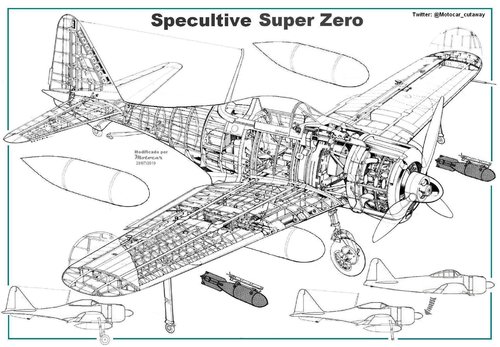

Attachments
Last edited:
Motocar
I really should change my personal text
- Joined
- 16 May 2014
- Messages
- 1,072
- Reaction score
- 1,122
Cutaway North American / Rockwell T-2A "Buckeye", the first version of the trainer of the US Navy, this made its first flight in 1958 and was propelled by a single engine Westinghouse J34-46 , entering service the following year after a few years underwent changes in its power plant by installing two units of the light and noisy General Electric J85 that provided bimotor security, remaining in service until the beginning of the 21st century. Author WEAL and retouched by Motocar to recreate this early and little known version of the US naval trainer.
Attachments
Motocar
I really should change my personal text
- Joined
- 16 May 2014
- Messages
- 1,072
- Reaction score
- 1,122
Free interpretation in speculative cutaway drawing Blohm & Voss BV-210View attachment 616616
- Joined
- 25 June 2014
- Messages
- 1,564
- Reaction score
- 1,498
Free interpretation in speculative cutaway drawing Blohm & Voss BV-210
I hate to say it but that drawing is totally wrong. It has no place on a serious factual thread. Serously, almost nothing about it is correct. The internal structure of both wing and fuselage were innovative and very different, the idea of external munitions is absurdly against all documented armament options, the main undercarriage is positioned incorrectly, I could go on and on. Leaving it here risks seriously misleading the casual visitor and everybody who then follows up their findings. Please delete it from here and save it for your own thread.
djfawcett
With Enough Power, Anything Will Fly
- Joined
- 16 December 2012
- Messages
- 274
- Reaction score
- 422
Free interpretation in speculative cutaway drawing Blohm & Voss BV-210
I hate to say it but that drawing is totally wrong. It has no place on a serious factual thread. Serously, almost nothing about it is correct. The internal structure of both wing and fuselage were innovative and very different, the idea of external munitions is absurdly against all documented armament options, the main undercarriage is positioned incorrectly, I could go on and on. Leaving it here risks seriously misleading the casual visitor and everybody who then follows up their findings. Please delete it from here and save it for your own thread.
Come on ....... the thread's title is "users artwork". It says nothing about a requirement that everything must be factual or has the appearance of being engineered correctly. I for one, totally enjoy Motocar's artwork.
- Joined
- 27 December 2005
- Messages
- 17,721
- Reaction score
- 26,229
Note that the cutaways here are not drawn by Motocar. He scans, cleans up, and edits them crudely in MS Paint or something.
archipeppe
ACCESS: Top Secret
- Joined
- 18 October 2007
- Messages
- 2,431
- Reaction score
- 3,147
I always loved so much Motocar's works.
He specialized in a field which so few want to dirt their hands.
One thing is to clearly depict an aircraft 3 views, another stuff is to get inside even if you do a patchwork job.
You must have a technical sensibility out of common, furthermore you must still have artistic capability.
So I will still to praise Motocar for his talent, rather blame him for some error.
He specialized in a field which so few want to dirt their hands.
One thing is to clearly depict an aircraft 3 views, another stuff is to get inside even if you do a patchwork job.
You must have a technical sensibility out of common, furthermore you must still have artistic capability.
So I will still to praise Motocar for his talent, rather blame him for some error.
- Joined
- 27 December 2005
- Messages
- 17,721
- Reaction score
- 26,229
I always loved so much Motocar's works.
He specialized in a field which so few want to dirt their hands.
One thing is to clearly depict an aircraft 3 views, another stuff is to get inside even if you do a patchwork job.
You must have a technical sensibility out of common, furthermore you must still have artistic capability.
So I will still to praise Motocar for his talent, rather blame him for some error.
Once again, Motocar doesn't create the cutaways. At most he can be credited with locating, scanning, and minor edits. Credits are due to Frank Munger, John Weal, Tim Hall, Mike Badrocke ("Aviagraphica"), Joe Picarella and other hugely talented artists.
archipeppe
ACCESS: Top Secret
- Joined
- 18 October 2007
- Messages
- 2,431
- Reaction score
- 3,147
Once again, Motocar doesn't create the cutaways. At most he can be credited with locating, scanning, and minor edits. Credits are due to Frank Munger, John Weal, Tim Hall, Mike Badrocke ("Aviagraphica"), Joe Picarella and other hugely talented artists.
Sure.
That's why I talked about "patchwork job".
The starting material isn't by Motocar, but he still does some art put it togheter to obtains something different if not new.
The same thing happens in music, how may time an artist used some champion of another one to realize a brand new song?
- Joined
- 27 December 2005
- Messages
- 17,721
- Reaction score
- 26,229
I'm not a fan personally. The terrible scanning offends my eyes.
I often edit drawings and clean up scans, but I've never felt the need to put my name inside the drawing or write "cleaned by Overscan" over the drawing.
I often edit drawings and clean up scans, but I've never felt the need to put my name inside the drawing or write "cleaned by Overscan" over the drawing.
archipeppe
ACCESS: Top Secret
- Joined
- 18 October 2007
- Messages
- 2,431
- Reaction score
- 3,147
I often edit drawings and clean up scans, but I've never felt the need to put my name inside the drawing or write "cleaned by Overscan" over the drawing.
This is clear, of course if you limit your activity in cleaning-up or enhancing there is no need to put your name above it.
If you take a scan, and modify it, change it (in substantial way), or mix up two or more scans to obtain something else, in this case you added value that the original work doesn't have.
It would be fair, anyaway, to put your name after the name(s) of the original author(s) just to give the right credit. imho.
- Joined
- 29 September 2006
- Messages
- 1,788
- Reaction score
- 1,357
This is clear, of course if you limit your activity in cleaning-up or enhancing there is no need to put your name above it.
If you take a scan, and modify it, change it (in substantial way), or mix up two or more scans to obtain something else, in this case you added value that the original work doesn't have.
It would be fair, anyaway, to put your name after the name(s) of the original author(s) just to give the right credit. imho.
That seems to be the standard over at Shipbucket, purveyors of fine ship illustrations: real, cancelled, and imagined.
- Joined
- 25 June 2014
- Messages
- 1,564
- Reaction score
- 1,498
Once again, Motocar doesn't create the cutaways. At most he can be credited with locating, scanning, and minor edits. Credits are due to Frank Munger, John Weal, Tim Hall, Mike Badrocke ("Aviagraphica"), Joe Picarella and other hugely talented artists.
Except that when he began this thread he said that "in order to give an identity to the hundreds of projects that lack a modest cutaway" ... "I never claimed to be a professional and it is important to note that they always say 'Free Interpretation' or 'provisional Interpretation.'" If you look closely at the BV P.210 wing root fairing you will see his signature - and no credit to anybody else. Maybe some of his cutaways are drawn from published sources and cleaned up, but his avowed purpose is to create original cutaways for types which have not yet been well served and this appears to be one of them. So Paul, with due respect, I simply cannot agree with a word of your claim.
I cannot recall who it was who prepared the original cutaway of the F-104 Starfighter for Flight, but he was so spot-on for a supposedly top secret design that the US authorities interviewed him to find out where he got his information from. He explained that if you were Lockheed then you had a certain track record and if you then went on to create this airframe with these rivet lines using that technology, then his drawing was what you would end up with.
Motocar certainly aspires to such heights but none of that design awareness is evident in the P.210 drawing, in fact wholly the reverse. It bears no comparison to the superlative technical quality of Mike Badrocke or Frank Munger. If you want to know more about the gentle art of cutaway drawing, I can recommend Bill Gunston's Classic World War II Aircraft Cutaways, Osprey, 1995 (and since republished by others). It contains much informative discussion alongside its many beautiful reproductions. So let's have no more of these unfounded claims.
This P.210 drawing was first posted in a supposedly factual thread on B&V types. In such circumstance it is important that its departure from reality should be made clear, this forum has a reputation for serious research and we do not want to dilute that.
I see that both the drawing and my initial criticism have now been moved here from that historical B&V discussion. That is good as far as it goes. But as a piece of research it is a poor example, no matter what apologia for the artist one wishes to make. If it is not to be moved to the fantasy/What-If section then it is fair game for exposing as the collection of mistakes that it is. Besides my earlier criticisms, if you compare it with the original drawings posted by newsdeskdan, you will see that even the profile of the nose and canopy is wrong. B&V's designer Richard Vogt used a trademark circular sheet steel main spar which doubled as an armoured fuel tank. For these high-speed jets the wing was too thin so he flattened the spar into an elongated D section torsion box which formed the whole front half of the wing structure. The rear edge of this sheet steel D is visible on the original B&V drawing but there is no sign of anything like that here, just a conventional light alloy framework. As a result the mistake of placing the main wheel wells too far forwards, as if the wing was unswept, has not been prevented. Do I really need to go on?
Last edited:
- Joined
- 27 December 2005
- Messages
- 17,721
- Reaction score
- 26,229
Once again, Motocar doesn't create the cutaways. At most he can be credited with locating, scanning, and minor edits. Credits are due to Frank Munger, John Weal, Tim Hall, Mike Badrocke ("Aviagraphica"), Joe Picarella and other hugely talented artists.
Except that when he began this thread he said that "in order to give an identity to the hundreds of projects that lack a modest cutaway" ... "I never claimed to be a professional and it is important to note that they always say 'Free Interpretation' or 'provisional Interpretation.'" If you look closely at the BV P.210 wing root fairing you will see his signature - and no credit to anybody else. Maybe some of his cutaways are drawn from published sources and cleaned up, but his avowed purpose is to create original cutaways for types which have not yet been well served and this appears to be one of them. So Paul, with due respect, I simply cannot agree with a word of your claim.
I cannot recall who it was who prepared the original cutaway of the F-104 Starfighter for Flight, but he was so spot-on for a supposedly top secret design that the US authorities interviewed him to find out where he got his information from. He explained that if you were Lockheed then you had a certain track record and if you then went on to create this airframe with these rivet lines using that technology, then his drawing was what you would end up with.
Motocar certainly aspires to such heights but none of that design awareness is evident in the P.210 drawing, in fact wholly the reverse. It bears no comparison to the superlative technical quality of Mike Badrocke or Frank Munger. If you want to know more about the gentle art of cutaway drawing, I can recommend Bill Gunston's Classic World War II Aircraft Cutaways, Osprey, 1995 (and since republished by others). It contains much informative discussion alongside its many beautiful reproductions. So let's have no more of these unfounded claims.
This P.210 drawing was first posted in a supposedly factual thread on B&V types. In such circumstance it is important that its departure from reality should be made clear, this forum has a reputation for serious research and we do not want to dilute that.
I see that both the drawing and my initial criticism have now been moved here from that historical B&V discussion. That is good as far as it goes. But as a piece of research it is a poor example, no matter what apologia for the artist one wishes to make. If it is not to be moved to the fantasy/What-If section then it is fair game for exposing as the collection of mistakes that it is. Besides my earlier criticisms, if you compare it with the original drawings posted by newsdeskdan, you will see that even the profile of the nose and canopy is wrong. B&V's designer Richard Vogt used a trademark circular sheet steel main spar which doubled as an armoured fuel tank. For these high-speed jets the wing was too thin so he flattened the spar into an elongated D section torsion box which formed the whole front half of the wing structure. The rear edge of this sheet steel D is visible on the original B&V drawing but there is no sign of anything like that here, just a conventional light alloy framework. As a result the mistake of placing the main wheel wells too far forwards, as if the wing was unswept, has not been prevented. Do I really need to go on?
Motocar is far from having the skill to do a cutaway drawing from scratch. That was my point. I certainly didn't mean to imply the P.210 was a great cutaway drawing.
I agree the P.210 cutaway is inaccurate, but I can guarantee it wasn't Motocar's fault - he didn't draw it. There are plenty of terribly inaccurate cutaways in existence - most of the Soviet types published in Air International during the Cold War are completely incorrect as they were based on scanty evidence. This P.210 cutaway, whoever drew it, was probably working from limited information.
I don't like these posts, but some people find value in them. I am happy for them to be confined to this topic - which users then avoid or read as they wish.
Motocar
I really should change my personal text
- Joined
- 16 May 2014
- Messages
- 1,072
- Reaction score
- 1,122
I welcome the criticism about the modest work of retouching, modifications and some original work that I have had to share well ..! Always with great respect for its original artists, I regret the valid but sterile controversy as long as it is aimed at putting the effort that is required to recreate an airplane that does not exist ... There are many hours of reliable sources searching, data , images and drawings to just get a little closer to what you thought when you created a drawing of an inconclusive project ...!
Since I put works in this forum I was quickly referred to this topic created by the administrators to accommodate these specimens drawings, I will only add that much of the technique I use is the same used by engineers to build a prototype just to mention 2 Grumman X-29 starting from the fuselage of the F-5E with the landing gear of the F-16 or the highly modified Fiat G-50 DB-601 or its training model ...! I am far from repeating the author's opinion but I can say who retouched it who is beyond cleaning an image ....! Finally, these works recreate the delight of the followers of these themes of the Cutaways. Thank you for your acid criticism of the most purists and the support of those who appreciate this effort that does not seek benefits or any economic use since they are not for sale "They are given away for free" as a comedian of my country would say ...! Successes to you. Motocar
Since I put works in this forum I was quickly referred to this topic created by the administrators to accommodate these specimens drawings, I will only add that much of the technique I use is the same used by engineers to build a prototype just to mention 2 Grumman X-29 starting from the fuselage of the F-5E with the landing gear of the F-16 or the highly modified Fiat G-50 DB-601 or its training model ...! I am far from repeating the author's opinion but I can say who retouched it who is beyond cleaning an image ....! Finally, these works recreate the delight of the followers of these themes of the Cutaways. Thank you for your acid criticism of the most purists and the support of those who appreciate this effort that does not seek benefits or any economic use since they are not for sale "They are given away for free" as a comedian of my country would say ...! Successes to you. Motocar
- Joined
- 25 June 2014
- Messages
- 1,564
- Reaction score
- 1,498
Could you or Motocar please explain to us then who did draw it and why it bears Motocar's signature (on the wing root fairing) but not theirs? If Motocar copied it from someone else without crediting them, is that acceptable? And whose cutaway did he copy? The 3-view profiles are of course our own Flitzer's, but I was not aware that he also did cutaways (am I perhaps ignorant of them? I am sure I would not be the only one). Why has the original not been uploaded here alongside? That would be of far greater research value in a Research Topics forum. I am sure you will appreciate that at the moment, the credibility gap between the claims and the evidence is still far too wide.I agree the P.210 cutaway is inaccurate, but I can guarantee it wasn't Motocar's fault - he didn't draw it.
I will stress, I have no problem with it as a piece of artwork, only with potentially false claims made as to its provenance and accuracy - claims with the potential to seriously mislead.
Motocar
I really should change my personal text
- Joined
- 16 May 2014
- Messages
- 1,072
- Reaction score
- 1,122
Motocar was the one who made the speculative cutaway that bothers him so much, rather than enjoying it as an attempt to show that failed Blohm & Voss project on a topic clearly dedicated to it, the BMW engine already seen in the cutaway of Heinkel He-162 was used , in part to maintain the same scale, otherwise I guarantee that many data are missing and the few available drawings are very blurry and of little value when it comes to recreating a cutaway. I'm sorry I bothered you with my cutaway and your speculations. I reiterate there are tweaks, modifications and some originals ...! Have an excellent day and enjoy this and other thread's .
Similar threads
-
Aleklicho renders of Argentine Unbuilt aircraft
- Started by Motocar
- Replies: 6
-
-
-
-

